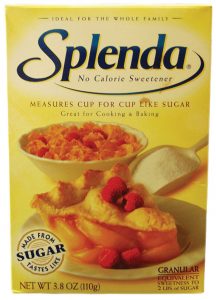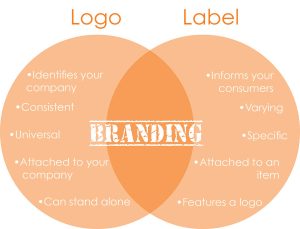Logos vs. Labels: What’s the Difference?
Introduction
Branding is a critical component for any company wanting to have a presence in the marketplace. Not only does branding entail the communications strategy used to communicate your company’s message, but it also relates to the emotions consumers have when they come in contact with your business. Messaging and communications, as well as marketing and promotional materials, work together to create a company’s brand.
Logos and labels are two marketing pieces used to build and communicate your company brand. When differentiating between a logo and label, it is easy to confuse the two. While both are vital, must-have elements for any company selling a service or product, they serve two different purposes.
What is a Logo?
A logo is a symbol used to identify your company that brings instant public recognition. Logos use colors, fonts and images to convey a unique visual identity to represent and communicate your brand. This symbol is often used consistently on all marketing materials, including signs, paper, promotional items, etc.
Effective logos should offer a combination of identification, distinction and communication of your company.
Identification: A logo identifies your company in the marketplace. It is often your first impression on potential customers. In a visually symbolic way, a logo represents your company to the outside world.
Distinction: An effective logo will distinguish you from competitors. New products appear in the market each day; an effective logo delivers distinction from other companies for customers to recognize and select.
Communication: Your logo should serve as a communication channel that says something about your company. Every logo says something about the company it represents, whether it is subtle or direct.
Font-based, literal illustrations and abstract symbols are the three most-used logo types.
Font-based: Consists solely of the company name in a unique font that makes it stand out, such as Coca-Cola.

Coca Cola’s logo is an example of a text logo.
Literal illustrations: Uses an illustration directly related to what the company does, such as a lawn mower alongside the name of a lawn-care service.

Example of a literal illustration logo.
Abstract symbols: Immediately identified with the company’s brand and image. This logo choice is a risky move, as it requires customers to immediately associate your company with that symbol. However, established companies often evolve into this once they have built a prominent identity, such as Nike, Apple and Starbucks.

Nike’s logo is an example of an abstract symbol.
What is a label?
A label is an item attached to a product to inform consumers with a variety of information about the product and should always display the company’s logo.
The Function of a Label
A label serves a multitude of purposes. One essential function of a label is to provide potential and existing consumers with information about the product. Labels offer mandatory information for packaged food products and state the facts of what is contained in the package. A proper label should include a principal display panel and an information panel. Labels also function as the first impression of a product. A label should carry a unique, visually appealing design that communicates your brand.
Principal Display Panel
The principal display panel is the part of a label that will first catch a consumer’s eye when shopping. This panel displays the common name of the product, the net quantity of contents and usually the logo or brand of the product (although the logo is optional and not required by law).

Information Panel
The information panel includes mandatory elements, including the ingredient listing, name and address of manufacturer, packer or distributor; number of servings, if used; nutrition facts labeling, if used; advisory statements, if needed; disclosure statement; and accompanying information (handling information, such as keep refrigerated, frozen, etc.). The information panel might also include non-regulatory information, including recipe ideas and the history of the company.

Example of a nutrition facts label.
Look of the Label
In addition to providing information, the label also provides consumers with a prior idea about the contents of the package. The label is one of the first things a consumer will see, basically an invitation for them to purchase your product. Labels with a smart combination of color, fonts and finish are more appealing, offering an eye-catching appeal to consumers.
Label Design
Form: This is the part where you can be creative with a product label. A label should reflect your company ideals and, although, sometimes more is better, less can be best when it comes to label design. Try to use no more than two fonts on a label, but do use different font sizes to add variety. When deciding on colors, try to select a few key colors that will complement the product and tie into your overall brand. Try to have an even balance of content and white space. A cluttered label can be overwhelming and drown out the information you really want customers to see.
Usability/Practicality: While a flashy label may lure the eye to a product, if it is not user-friendly, consumers probably won’t waste their time with it. Make sure the label is easy to read and information is easy to find.
Summary
Logos and labels work together to accomplish a similar goal – promoting your brand. However, while a logo serves as a symbolic visual identifier for your company, a label is used to provide information about a product or service offered by your company.
References
Bourn, Jennifer. “What is the Difference Between a Logo and a Brand?” Bourn Creative. www.bourncreative.com. October 2, 2009.
Designmondo. “35 Stylish Wine Label Design Examples.” http://designmodo.com/wine-label-designs/. January 18, 2012.
Gillikin, Jason. “Importance of Logos in Business.” The Houston Chronicle. http://smallbusiness.chron.com/importance-logos-business-577.html. 2013.
Martin, Megan. “What is a Company Logo?” The Houston Chronicle. http://smallbusiness.chron.com/company-logo-3479.html. 2013.
Morris, Richard. “Smart Tips for Designing Your Own Food Labels.” Hand Picked Nation. January 28, 2013.
My Markets. “Know What a Logo Does.” My Markets Logo Designer, 2005.
Scott, Darren, Bowser Timothy, McGlynn, William. “Food Product Labeling Basics: FAPC Factsheet 140.” Robert M. Kerr Food & Agricultural Products Center. July 2010.
Rebecca Bailey
FAPC Communications Graduate Assistant
Mandy Gross
FAPC Communications Services Manager

